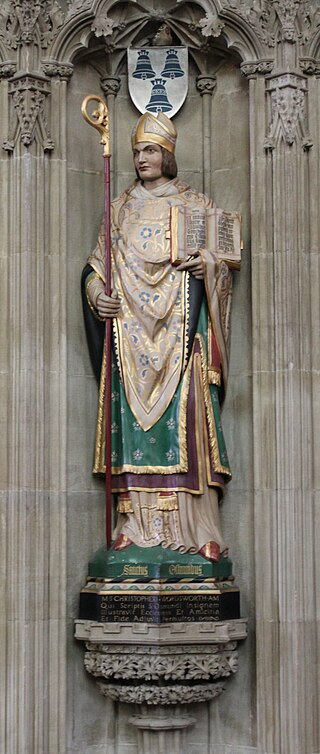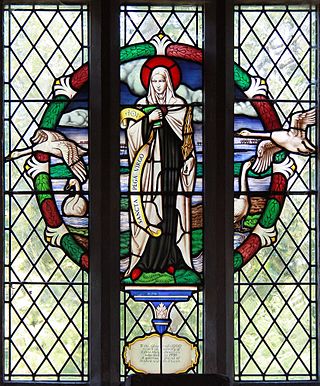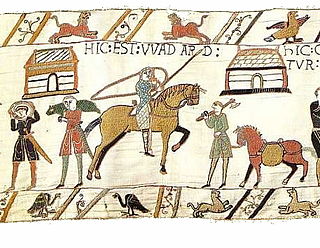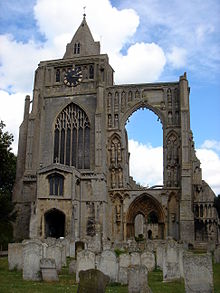
William II was King of England from 26 September 1087 until his death in 1100, with powers over Normandy and influence in Scotland. He was less successful in extending control into Wales. The third son of William the Conqueror, he is commonly referred to as William Rufus, perhaps because of his ruddy appearance or, more likely, due to having red hair.

Crowland or Croyland is a town in the South Holland district of Lincolnshire, England. It is situated between Peterborough and Spalding. Crowland contains two sites of historical interest, Crowland Abbey and Trinity Bridge.

The Croyland Chronicle, also called Crowland Chronicle, is an important primary source for English medieval history, particularly the late 15th century. It is named for its place of origin, the Benedictine Abbey of Croyland or Crowland, in Lincolnshire, England. It was formerly also known as the Chronicle of Ingulf or Ingulphus after its supposed original compiler, the 11th-century abbot Ingulf. As that section of the text is now known to have been a later forgery, its author is instead known as Pseudo-Ingulf. The validity of the source itself has been questioned, partially due to the unknown identity of the original author, and gaps in all continuations of the text. There has also been substantially little effort made to find and translate the original manuscript.
Robert of Jumièges was the first Norman Archbishop of Canterbury. He had previously served as prior of the Abbey of St Ouen at Rouen in Normandy, before becoming abbot of Jumièges Abbey, near Rouen, in 1037. He was a good friend and adviser to the king of England, Edward the Confessor, who appointed him bishop of London in 1044, and then archbishop in 1051. Robert's time as archbishop lasted only about eighteen months. He had already come into conflict with the powerful Earl Godwin and, while archbishop, made attempts to recover lands lost to Godwin and his family. He also refused to consecrate Spearhafoc, Edward's choice to succeed Robert as Bishop of London. The rift between Robert and Godwin culminated in Robert's deposition and exile in 1052.
Waltheof, Earl of Northumbria was the last of the Anglo-Saxon earls and the only English aristocrat to be executed during the reign of William I.
Robert Mannyng was an English chronicler and Gilbertine monk. Mannyng provides a surprising amount of information about himself in his two known works, Handlyng Synne and Mannyng's Chronicle. In these two works, Mannyng tells of his residencies at the Gilbertine houses of Sempringham and Sixhills, and also at the Gilbertine priory at Cambridge, St Edmund’s.

Osmund, Count of Sées, was a Norman noble and clergyman. Following the Norman conquest of England, he served as Lord Chancellor and as the second bishop of Salisbury, or Old Sarum.

Pega is a Christian saint who was an anchoress in the ancient Anglo-Saxon kingdom of Mercia, and the sister of St Guthlac.

The Harrying of the North was a series of military campaigns waged by William the Conqueror in the winter of 1069–1070 to subjugate Northern England, where the presence of the last Wessex claimant, Edgar Ætheling, had encouraged Anglo-Saxon Northumbrian, Anglo-Scandinavian and Danish rebellions. William paid the Danes to go home, but the remaining rebels refused to meet him in battle, and he decided to starve them out by laying waste to the Northern shires using scorched earth tactics, especially in the historic county of Yorkshire and the city of York, before relieving the English aristocracy of their positions, and installing Norman aristocrats throughout the region.

Abingdon Abbey was a Benedictine monastery in Abingdon-on-Thames in the modern county of Oxfordshire in the United Kingdom. Situated near to the River Thames, it was founded in c.675 AD and was dedicated to Mary, mother of Jesus. It was disestablished in 1538 during the dissolution of the monasteries. A few physical remnants of the Abbey buildings survive within Abingdon-on-Thames.

Anglo-Saxon missionaries were instrumental in the spread of Christianity in the Frankish Empire during the 8th century, continuing the work of Hiberno-Scottish missionaries which had been spreading Celtic Christianity across the Frankish Empire as well as in Scotland and Anglo-Saxon England itself during the 6th century. Both Ecgberht of Ripon and Ecgbert of York were instrumental in the Anglo-Saxon mission. The first organized the early missionary efforts of Wihtberht, Willibrord, and others; while many of the later missioners made their early studies at York.
Eosterwine was the second Abbot of Wearmouth (Sunderland) in Northumbria (England).

Crowland Abbey is a Church of England parish church, formerly part of a Benedictine abbey church, in Crowland in the English county of Lincolnshire. It is a Grade I listed building.
William of Ramsey was a 13th-century English Benedictine monk of Croyland Abbey, born at Ramsey, Huntingdonshire.

Thurcytel was abbot of Crowland and perhaps also of Bedford Abbey.
Lucy of Bolingbroke or Lucia Thoroldsdottir of Lincoln was an Anglo-Norman heiress in central England and, later in life, countess of Chester. Probably related to the old English earls of Mercia, she came to possess extensive lands in Lincolnshire which she passed on to her husbands and sons. She was a notable religious patron, founding or co-founding two small religious houses and endowing several with lands and churches.
Ralph Basset was a medieval English royal justice during the reign of King Henry I of England. He was a native of Normandy, and may have come to Henry's notice while Henry held land in Normandy prior to becoming king. Basset is first mentioned in documents about 1102, and from then until his death around 1127, he was frequently employed as a royal justice. His son Richard Basset also became a royal judge.
Ingulf was an 11th-century Benedictine abbot of Crowland (Croyland).
Hugh de Beauchamp was a Norman who held lands in England after the Norman Conquest.

Wadard was an 11th-century Norman nobleman who is mentioned in the Domesday Book of 1086, and is depicted in the Bayeux Tapestry.









